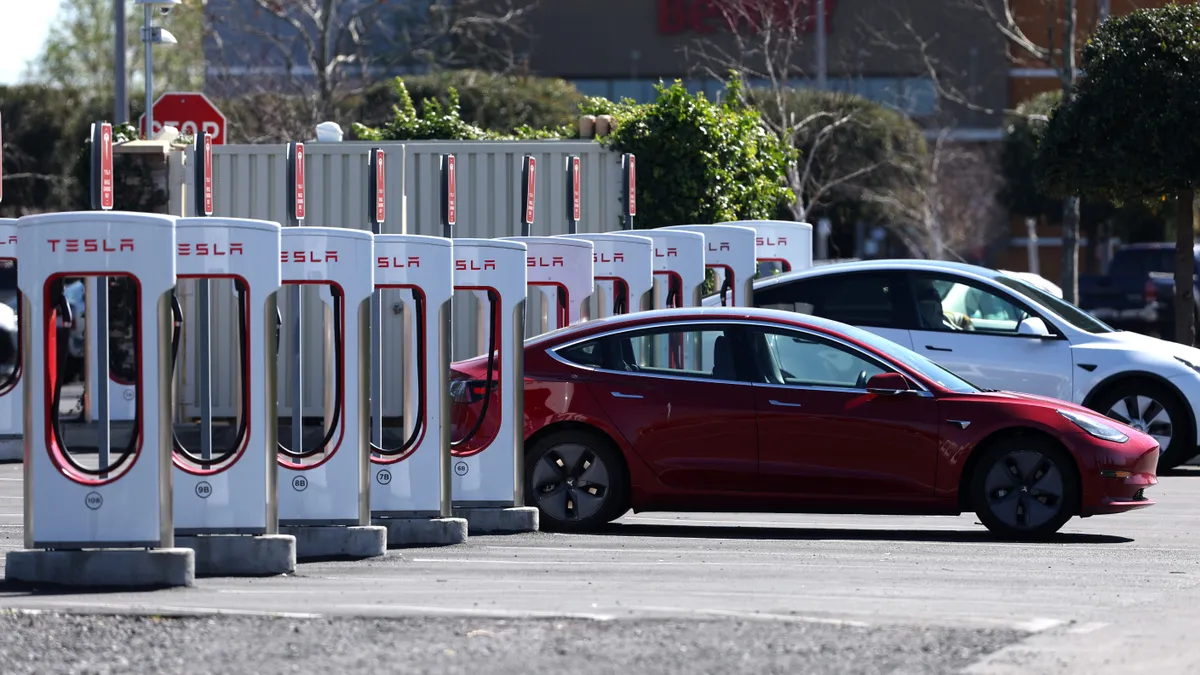Electric vehicle sales are booming, but experts say continued growth in the sector depends on expanding global battery production — and several factors could complicate that effort.
Both in the United States and globally, sales of EVs and plug-in hybrids are growing at about a 50% year-over-year rate, according to Victor Irle, co-founder of EV Volumes. The company tracks monthly sales around the world by vehicle model.
In 2021 there were about 6.8 million EVs and plug-in hybrids sold globally — and in just the first half of this year, about 5.1 million were sold. “We're probably already over last year’s full-year results,” Irle said. “You see that there is double-digit growth each and every month.”
Irle spoke Tuesday at the Novi Battery Show, outside of Detroit. The conference is hosted by Informa, which recently purchased Industry Dive.
Full-year 2022 global sales of EVs and PHEVs could reach 10.9 million, Irle said. Meanwhile, global sales of internal combustion engine vehicles are down 14%, year-to-date.
“By the end of the year, this number is probably going to be slightly higher because electric vehicles tend to sell better in the second half,” he said.
But experts say continued, rapid EV adoption will depend on a steady supply of batteries. Private industry and global governments are pouring billions into mining, materials processing, and component manufacturing and assembly.
In the U.S., battery plant manufacturing capacity is set to increase 428% by 2026, from 59 GWh in 2021 to 343.5 GWh, according to Anthony Burrell, head of energy storage at the National Renewable Energy Laboratory.
And automakers are investing $71.5 billion from 2017 through 2030 to electrify products, including new assembly plants and battery factories, he said. Those investments are alongside almost $7 billion in support by the federal government for battery materials processing and cell manufacturing, and another $7.5 billion to develop EV charging infrastructure.
“This curve, this predicted growth of battery development ... is remarkable,” Burrell said. He also cautioned that projections for battery production are often revised by analysts because growth rates for new technologies can be “unpredictable.”
“Like most of these technologies that are changing our world, they are significantly accelerated by public acceptance and cost reduction drivers in the market,” he said. “The problem we have keeping these slides up to date, is the announcements are coming out like daily.”
The global battery market is expected to grow at around a 34% compound annual growth rate, according to Robert Galyen, formerly the chief technology officer at CATL, the world’s largest battery manufacturer. He now does consulting work through his company Galyen Energy.
That battery growth rate represents somewhere between $100 billion and $300 billion worth of investment by 2030. “That’s a massive amount of money that's going to be spent on a new industry,” Galyen said.
But there are “growing pains” that can bedevil electrification efforts, he added, including governments developing incentives and regulations without fully understanding the sector.
“There are problems with understanding how complex this industry really is,” Galyen said. “It's all about chemistry. It's all about industrialization. And it's all about bringing value to the shareholders.”
There is large demand for critical minerals for batteries and a lack of processing capability, he said. Other issues include the need to time the development of charging EV infrastructure alongside battery production, and the potential for supply chain constraints to hold back new manufacturing facilities.
“Building materials are becoming scarce,” Galyen said. “I'm working with several companies right now on constructing new plants. Just to stand up structural steel is somewhere around the 50- to 54-week lead-time, depending upon how much purchasing power you've got.”
Similar issues exist for concrete and roofing materials, he said.
“Most of these factories are huge. The last time I sized a 15-GWh factory it was roughly 44 acres under one roof. That's a lot of roofing material,” Galyen said.














